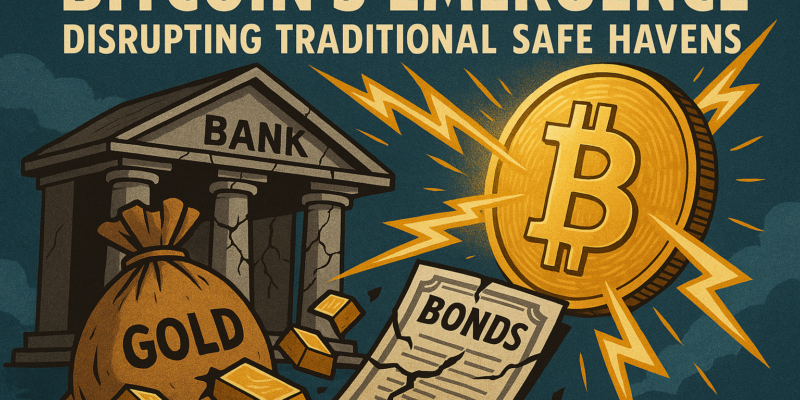Bitcoin’s Emergence: Disrupting Traditional Safe Havens
Introduction
For generations, investors have turned to assets like gold and government-issued bonds as safe havens during times of economic turmoil. These traditional investments have long been synonymous with capital preservation and stability when markets experience uncertainty. However, the foundation of that assumption is beginning to shift. In an economy increasingly defined by digital disruption, ballooning debt, and political instability, Bitcoin (BTC) is emerging as a powerful contender to traditional financial instruments. The Contrarian Investor is already paying attention, recognizing Bitcoin as possibly the most compelling asymmetric investment opportunity of our era.
More than just digital currency, Bitcoin represents a major evolution in how we think about value. With a fixed supply, decentralized architecture, and independence from government control, Bitcoin is becoming increasingly relevant in today’s macroeconomic environment. Investors searching for ways to safeguard their wealth are now seriously considering Bitcoin as a viable hedge against inflation, currency debasement, and systemic failures within the traditional financial system.
Traditional Safe Havens vs. Bitcoin
Gold has served as a store of value for thousands of years. Its physical scarcity and historical role as a form of money made it the go-to asset during economic downturns. Government bonds — particularly U.S. Treasury bonds — also gained prominence as “risk-free” assets, offering predictable yields backed by the full faith of sovereign governments. However, both of these assets now face growing limitations in an age of accelerating digital transformation and monetary expansion.
Gold, while globally recognized and historically reliable, suffers from several drawbacks in today’s digital economy. It is cumbersome to store, difficult to transport, and cannot be transacted digitally without centralized intermediaries. Moreover, its value appreciation has stagnated when adjusted for inflation, providing limited upside in a rapidly evolving financial landscape.
U.S. Treasury bonds are likewise facing headwinds. When inflation rises faster than interest rates, investors often realize negative real returns. With central banks around the world printing trillions of dollars to stimulate sluggish economies, real yields on many bonds have plummeted, and sovereign debt levels have reached historic highs, raising concerns about long-term sustainability.
Bitcoin stands in stark contrast to these instruments. It is a fully digital, algorithmically scarce asset, verifiably capped at 21 million units. Borderless, decentralized, and trustless, Bitcoin allows users to store and transfer value without depending on traditional financial intermediaries. Its divisibility and portability make it ideal for micro and macro transactions alike. It operates globally 24/7 and remains accessible to anyone with an internet connection, making it far superior in terms of mobility and functionality when compared to gold or bonds.
Why Bitcoin Is Gaining Momentum
Bitcoin’s ongoing ascent into mainstream consciousness is supported by a confluence of factors ranging from macroeconomic instability to technological adoption. The narrative around Bitcoin has evolved: it’s no longer just for early adopters or tech-savvy libertarians. Today, institutional investors, public companies, and even national governments are viewing Bitcoin not just as a curiosity, but as a cornerstone of tomorrow’s financial infrastructure.
- Institutional Adoption: Financial giants like BlackRock, Fidelity, and Vanguard have begun offering Bitcoin-related financial products, including the increasingly popular Spot Bitcoin ETFs. These products have significantly lowered the barrier to entry for mainstream investors, allowing traditional portfolios to gain exposure to Bitcoin in a regulatory-compliant and custodially secure manner.
- Economic Instability: With central banks around the world engaging in unprecedented levels of quantitative easing, fiat currencies are becoming increasingly unstable. Trillions in new currency issued over the past few years have devalued purchasing power and eroded savings. Learn more about the flaws and risks inherent in Fiat Money.
- Changing Demographics: Millennials and Gen Z investors, many of whom have grown up during financial crises and witnessed the limits of conventional finance, are far more likely to adopt decentralized digital assets. These generations favor transparency, self-custody, and borderless networks — all of which are core attributes of Bitcoin.
- Digital Scarcity: While central banks can print money endlessly, Bitcoin has a hard-coded limit of 21 million coins. This finite supply, coupled with predictable issuance through the Bitcoin halving events every four years, positions Bitcoin as a credible deflationary asset. Its scarcity offers protection against rampant inflation and monetary debasement.
Financial Benefits of Investing in Bitcoin
One of the most compelling aspects of investing in Bitcoin lies in its potential for exponential returns compared to traditional assets. Although Bitcoin exhibits high volatility in the short term, it has historically delivered outsized gains for long-term holders. Over the past decade, Bitcoin has outperformed tech stocks, gold, real estate, and most commodities.
Investors who entered early often saw returns of 10x, 50x, or even 100x. While such massive upside is increasingly rare as Bitcoin matures, significant long-term growth potential remains due to institutional demand, scarce supply, and growing global adoption. With the next halving event expected soon, many analysts forecast upward price pressure due to the resultant reduction in new supply. For more expert outlooks, explore our comprehensive Bitcoin Price Prediction analysis.
Beyond profits, Bitcoin also offers strategic value as a diversification tool. Even allocating just 1–5% of your investment portfolio to Bitcoin can improve your portfolio’s overall risk-adjusted returns. Bitcoin’s low correlation to traditional assets makes it particularly attractive in times of market distress. By including an uncorrelated asset in one’s diversified portfolio, investors can potentially reduce overall risk while increasing return potential.
Risks and Considerations
While the upside is significant, prospective Bitcoin investors must also consider the risks that come with the territory. Bitcoin is known for price volatility — the asset can experience double-digit percentage moves in a single day. Outside forces such as regulatory updates, geopolitical events, or market manipulation can greatly impact short-term price performance.
Security is another critical concern. Unlike traditional bank accounts, Bitcoin ownership requires the investor to manage their own private keys. Without proper safeguards, Bitcoin can be lost or stolen. Solutions such as hardware wallets, multi-signature wallets, and reputable custodial services help to mitigate these risks but require education and vigilance.
Regulatory uncertainty also looms large. Cryptocurrencies are still operating in a largely unregulated environment in many parts of the world, although this is changing rapidly. Governments from the U.S. to the EU and Asia are crafting new rules to govern the space. Some see regulation as a threat, but others view it as a sign of maturation and potential legitimacy, which could ultimately introduce more capital into the Bitcoin ecosystem.
Strategies for Maximizing Returns
Investing in Bitcoin effectively requires a thoughtful and strategic approach, especially for those new to the digital asset space. Here are a few time-tested strategies that can help you navigate the volatility and optimize for long-term gains:
- Dollar-Cost Averaging (DCA): By investing a fixed amount at regular intervals, you mitigate the risk of entering the market at a peak. This strategy is ideal for investors looking to accumulate Bitcoin over time without worrying about short-term price movements.
- HODLing: The term “HODL” — Hold On For Dear Life — reflects the strategy of holding Bitcoin long-term through market cycles. This approach has historically rewarded early adopters, as natural cycles of volatility ultimately trend upward over time.
- Rebalancing: Incorporate Bitcoin exposure within a larger investment framework. Review and adjust Bitcoin allocations regularly based on portfolio performance and market sentiment.
- On-Chain Analytics: Tools like Glassnode and CryptoQuant offer real-time data on wallet movements, mining operations, and exchange flows. These metrics can provide leading indicators of market behavior, helping you make more informed investment decisions.
- Stay Informed: The crypto ecosystem evolves rapidly. Regularly reading reputable news sources, joining crypto communities, and participating in educational platforms can keep you ahead of the curve.
Conclusion
Bitcoin is no longer a speculative asset hidden in fringe online communities. It has grown into a globally recognized financial instrument with the potential to redefine value, ownership, and wealth preservation in the coming decades. As inflation rises and trust in traditional financial structures wanes, more people are turning to Bitcoin as a hedge, store of value, and means of financial sovereignty.
We are in the midst of a generational paradigm shift. Bitcoin is rapidly transitioning from being a contrarian bet to a strategic component in modern investment portfolios. Its decentralized nature, predictable supply, and global accessibility make it increasingly difficult to ignore. Whether you’re an early adopter or a curious observer, understanding Bitcoin now could place you ahead of the mainstream curve.
Embrace the future of finance. Bitcoin might not just be an alternative — it may very well be your best shot at financial resilience in an uncertain world.













